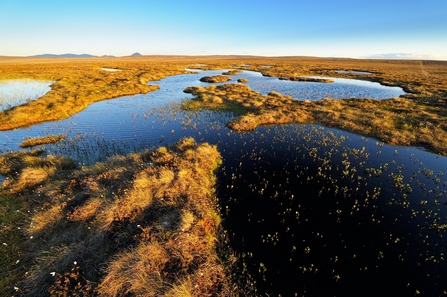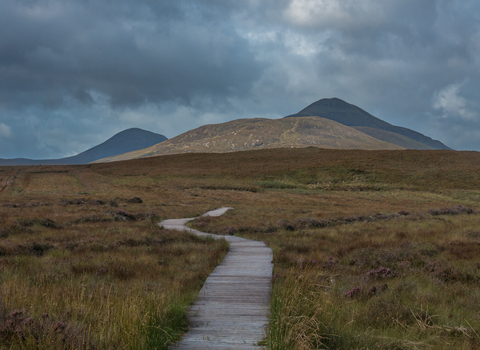Blanket bog
A blanket bog is a peatland that stretches over flat plains and gently sloping hillsides, covering the landscape like a blanket. Blanket bogs are often treeless environments with low-lying vegetation consisting of mosses, sedges and dwarf shrubs. The variety of low-lying vegetation, interspersed with pools of standing water, often give blanket bogs a patchwork appearance.
Blanket bogs are often found over acidic bedrock where rainfall exceeds the loss of water, creating a waterlogged environment that allows peat to form. Blanket bogs are ombrotrophic (fed only by precipitation) which makes them nutrient-poor and acidic - surface water and soil pH values between 3.2 and 4 are common in Sphagnum-dominated bogs.
Such conditions do not support a large diversity of vascular plants but favour the growth of bog mosses and a range of specialists unique to these habitats. Sphagnum mosses typically carpet healthy bogs and create an undulating topography with hummocks and hollows. Other typical bog species include cottongrasses (Eriophorum spp.), butterworts (Pinguicula spp.), bladderworts (Utricularia spp.) and bog specialists such as carnivorous sundews (Drosera spp.). Blanket bogs are also home to invertebrates such as black darter (Sympetrum danae), common hawker dragonfly (Aeshna juncea) and large heath butterfly (Coenonympha tullia), and wading birds including dunlin (Calidris Alpina) and plover (Pluvialis apricaria).
In the UK, blanket bog can be found from lowlands at sea level up to 1000 metres above sea level, but it typically occurs in wetter uplands in the west and north where extensive areas are covered by peat. Upland blanket bogs are characterised by a thinner peat layer (average maximum depth of 6 m) compared to lowland blanket bogs, where peat often extends deeper but tends to cover less extensive areas. Uplands tend to have a thinner layer of peat because much of the upland blanket bog has been forming for a shorter period (often 5-6,000 years) and because the sloping landscape prevents effective waterlogging, which is key for peat accumulation. In the wettest upland areas of Britain, peat generally occurs on slopes around 20° but can still form on slopes as steep as 40°, whereas in drier regions, peat may not be able to accumulate even on gentle slopes. Upland blanket bogs in the UK are therefore diverse habitats in terms of peat depth, which can naturally vary from a few centimetres to several metres over distances as short as 50-100 metres.
Blanket bog is globally rare, but Britain and Ireland hold 20% of the world’s blanket bog, meaning that UK blanket bog is of international importance. The most intact and extensive blanket bog in the world - The Flow Country – can be found in northern Scotland. In 2024, the Flow Country was inscribed as a World Heritage Site by UNESCO, making it the first and only peatland World Heritage Site in the World.

Forsinard Flows National Nature Reserve. Credit Lorne Gill, SNH
Degraded and drained blanket bogs can look very different from healthy bogs. Signs of erosion and fragmentation are often visible, and the scarcity of bog vegetation can leave sections of dark peat exposed on the surface. Sphagnum moss that is characteristic of healthy bogs is scarce or absent, and grasses and shrubs such as purple moor grass, heather and hare’s tail cottongrass begin to dominate the drier surface. The hummock/pool topography characteristic of bogs is lost, and over time, degraded blanket bogs can begin to resemble heathlands.
Read more about threats to peatlands.










